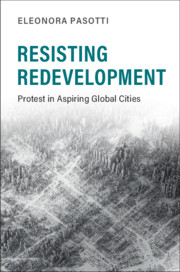Book contents
- Resisting Redevelopment
- Cambridge Studies in Contentious Politics
- Resisting Redevelopment
- Copyright page
- Dedication
- Contents
- Illustrations
- Acknowledgments
- Part I Setting the Comparison
- Part II Explaining Mobilization
- Part III Explaining Impact
- 9 Council Allies and Partisan Alignments
- 10 Shaping Redevelopment in Public Housing Estates
- 11 Militancy with a Twist
- 12 Conclusion
- Book part
- Bibliography
- Index
- Cambridge Studies in Contentious Politics
12 - Conclusion
from Part III - Explaining Impact
Published online by Cambridge University Press: 09 March 2020
- Resisting Redevelopment
- Cambridge Studies in Contentious Politics
- Resisting Redevelopment
- Copyright page
- Dedication
- Contents
- Illustrations
- Acknowledgments
- Part I Setting the Comparison
- Part II Explaining Mobilization
- Part III Explaining Impact
- 9 Council Allies and Partisan Alignments
- 10 Shaping Redevelopment in Public Housing Estates
- 11 Militancy with a Twist
- 12 Conclusion
- Book part
- Bibliography
- Index
- Cambridge Studies in Contentious Politics
Summary
The conclusion elaborates on the implications of the use of experiential tools in violent or confrontational tactics, with special attention to the militant protest and rent strikes organized in Los Angeles by Union de Vecinos and the Los Angeles Tenants Union. It then examines lessons derived from the case studies that can be useful in limiting displacement, summarizing and expanding on various resistance strategies toward prevention, mitigation, and provision of alternatives to residential displacement in the face of gentrification and urban redevelopment. It reviews various approaches emerging from the case studies in the book regarding rent stabilization and compensation. It focuses on a comparison between community benefit agreements and Toronto's Section 37 funding, a legislated development impact fee. It also illustrates examples of community planning and construction, for example with land trusts.It concludes by arguing that experiential tools – despite their effectiveness in protest – can ultimately have the paradoxical effect of promoting rises in property prices, and the associated displacement.
Keywords
Information
- Type
- Chapter
- Information
- Resisting RedevelopmentProtest in Aspiring Global Cities, pp. 324 - 336Publisher: Cambridge University PressPrint publication year: 2020
